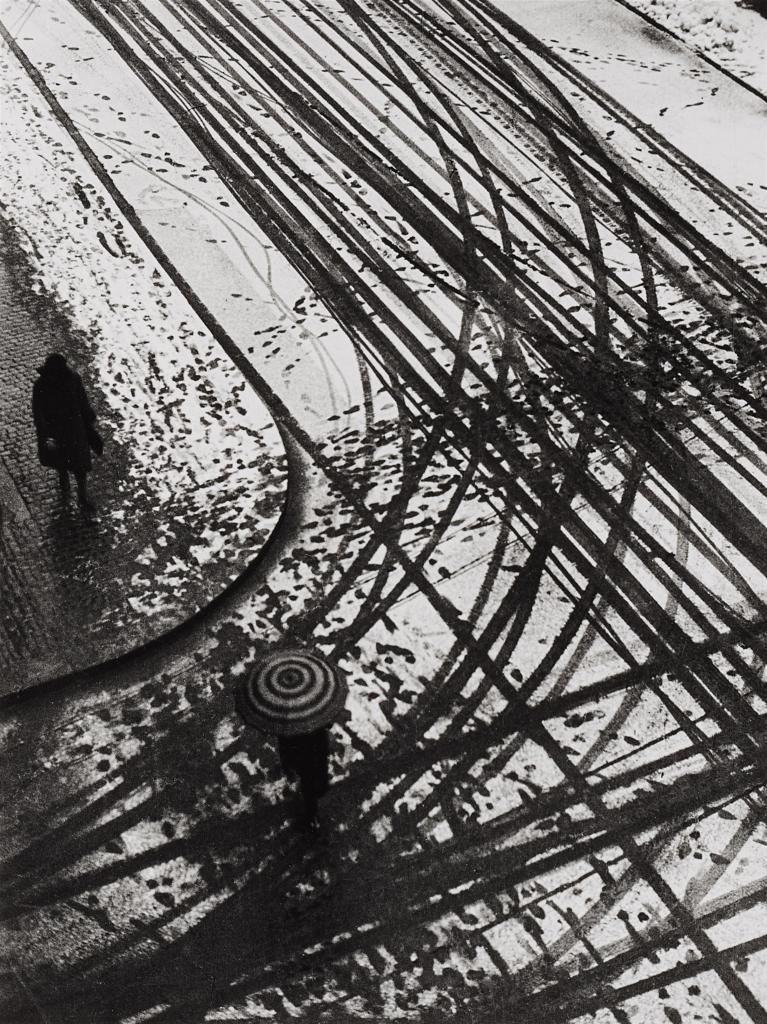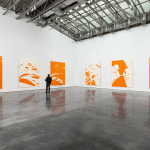
Contributed by Saul Ostrow / With exhibitions such as “AS/AS: Anton Stankowski / Adam Simon” at Osmos Address, where the artists works are paired, a message is sent that the art is not intended to be merely evaluated on its own terms but is also to serve an instructional purpose. It implies the viewer is to make comparisons and draw conclusions as to how each artist in his own manner approaches common subjects. To do this, the viewer is called upon to activate any number of frames of reference from the aesthetic to the historical to gain insight into the workings of each artist.

Given what is being asked of viewers, it is necessary for them to know that Anton Stankowski (1906-1998) lived and worked in Germany as a graphic designer and painter and that Adam Simon (b.1952) is an artist who lives and works in Brooklyn, NY. In the 1920s, Stankowski studied at the Folkwang School in Essen, a university that specialized in training students in music, theatre, dance, and design. Soon after, he began his career as a graphic designer and photographer, also creating an archive of stock photographic imagery for use in designing advertisements. By the 1970s, Stankowski was known for his logo designs, which includes those for Deutsche Bank, the city of Berlin, and SDR, the German Southwestern Broadcasting Corporation.


In contrast, Adam Simon went to The New York Studio School of Drawing, Painting & Sculpture in NYC to train to be a painter and went on to be one of the founders of the alternative art space Four Walls (19842000). His career has not been oriented to or dominated by commercial art. He instead translates logos, art-historical imagery, and stock photographs into stencils, whose silhouetted imagery he transfers onto canvas by means of thin layers of semi-transparent paint.

The convergent interests of these two artists, separated by 50 years, coming from two different fields, who had never met and were unfamiliar with each other’s work, may be written off as an odd coincidence. But, obviously not, in that the art dealer/ writer / curator Cay Sophie Rabinowitz has successfully placed Simon and Stankowski in dialog with one another. This was initiated by her knowledge of their common interest in photographic stock imagery, corporate logos, art-historical references, and geometric abstraction. What is of interest is how Stankowski addresses each of these subjects as a discrete entity across all media, from photography and graphic design to painting and printmaking, while Simon employs them all as the source of iconic imagery for his paintings.

The cultural anthropologist George Kubler, in his book The Shape of Time, theorizes that cultures tend to be out of sync with the material conditions of their societys existence. This lag produces cognitive dissonance, which requires that the outmoded symbolic means of representation be revitalized or reformulated by way of an erratic process in which messages sent forward from one generation to another are adapted to contextual challenges and changes, which results in various aspects being edited out, garbled, made minor, elevated, abnegated, and subjugated while the new is assimilated. Conceptually, this reveals the immanent potential within the existent forms, giving rise to new formats, practices, and contents. The result is that each era generates a particular image/style of its own adapted to its changed circumstances, existent forms, standards, criteria, and values. A failure to do so leads to degeneration, entropy, and collapse.
As Kubler also points out, themes, practices and forms are sent forward, until they no longer serve a purpose and even then may re-emerge. Subsequently, the conclusion may be drawn that these two artists each focus on their generations relationship to a specific historical problem, which indexes to the material conditions under which they live. Seen side-by-side, as they are in this exhibition, it is apparent that neither is interested in the imitation and reproduction of appearances, and that instead together they represent a diachronic and dialogic moment, marking off a segment of the project of deconstructing representation as it relates to our evolving comprehension of the act of signification.
As we all (should) know by now, representation in all its forms, be it words, symbols or paintings of recognizable things, is abstract, in that it is a result of our ability to formulate distinct concepts from our encounters with things, and in turn assign to these concepts (arbitrary) signifiers. Within the context of semiotics, Simon and Stankowski are intent on investigating the formal relationships and mental processes that determine their works parameters. In this, they may both be considered formalists, concerned with the subjective and objective terms that dictate their works identities and its reception.

The difference between the two artists may be accounted for by the fact Stankowski is working in the age of mechanical reproduction when each thing might still be considered singularly, even though categorically they share some fundamentals traits in common while Simon works in the context of the technological era in which differences are in collapse, giving way to a type of transparency where opacity once promised substance and comprehension. With the recognition of their differences and similarities, Simon and Stankowskis work with images may be seen as part of a larger continuum, in which their endeavors represent solutions to evolving historical problems. Thus their iterations represent stages in an ongoing process of innovation, replication, and mutation, which forms a continuous conversation through time.
About the author: Saul Ostrow is an independent curator and critic, and the Art Editor at Large for Bomb Magazine. His book Formal Matters (selected and revised) published by Elective Affinities will be launched fall, 2021. As a curator since 1985, he has organized over 80 exhibitions in the US and abroad. His writings have appeared in art magazines, journals, catalogues, and books in the USA and Europe. In 2010, along with David Goodman and Edouard Prulehiere, he founded the not-for-profit Critical Practices Inc. as a platform for critical conversation and cultural practices. He served as Co-Editor of Lusitania Press (1996-2004) and as the Editor of the book series Critical Voices in Art, Theory and Culture (1996-2006) published by Routledge, London. He has an MFA in Studio Practices from the University of Massachusetts, and was a practicing artist until 1994.
Related posts:
Adam Henry: Full spectrum
Ideas and Influences: Adam Simon
EMAIL: Clouds exhibition details from Adam Simon
Lauren Luloff: Absorbed into color























The artist Adam Simon is simply brilliant in his sensibilities that show complex movement and color tonality . How Simon achieves movement in his relatively static stock materials is part of his genius. Jog is a wonderful representation of Simon�s style seemingly light years from his beginnings in the Studio School yet still capturing something of that dynamism and action associated w abstract expressionism